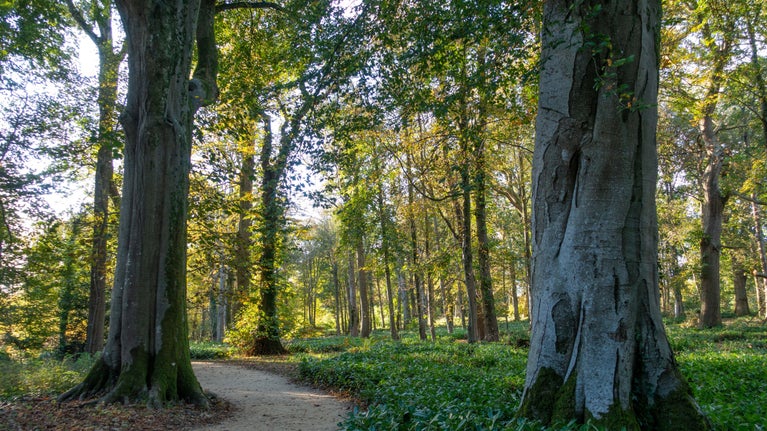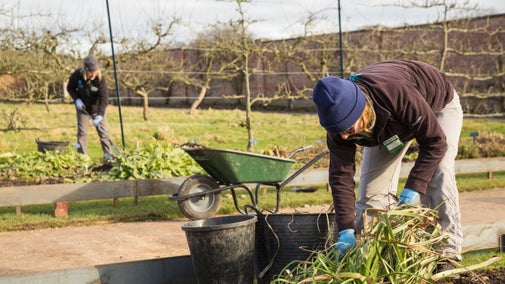
Discover more at Kingston Lacy
Find out when Kingston Lacy is open, how to get here, the things to see and do and more.

Relax in the garden at Kingston Lacy, Dorset, with a gentle stroll or a brisk walk; you'll be sure of far-reaching views. The changing seasons bring interest to areas ranging from the Fernery and formal garden to the South Lawn and Kitchen Garden. Come in the spring for cherry blossom, in autumn for flaming red Japanese maples, and in winter for carpets of snowdrops.
Kingston Lacy has a fabulous winter garden, with snowdrops blossoming among the bamboo and winter-flowering cherries in the Japanese garden and Nursery Wood. Look out, too, for Hamamelis (witch-hazel), with its vibrant blooms on bare twigs, and the speckled flowers of Hellebores. You’ll smell wintersweet (Chimonanthus praecox) before you see it! In Nursery Wood the camellias are the first stars of the show, before the magnolias and azaleas get going later in the spring (March).
The Fernery has Cyclamen coum and Cyclamen hederifolium to start the season off. As the snowdrop is one of the first bulbs to flower in the gardening calendar it marks the start of the spring colours. We look forward to daffodils (massed along Lime Walk), iris reticulata and crocus; then the colourful hyacinths and tulips that will fill the garden (in total over 50,000 bulbs emerge during this time of year).
There are great winter walks around the parkland – the Woodland Walk is suitable for pushchairs as well as being filled with snowdrops. Keep an eye out for the rare breed Portland sheep and Red Ruby Devon cattle – it’s normally March before the lambs and calves appear, but there might be some early arrivals.
Snowdrops have been part of the garden at Kingston Lacy for more than a century. Henrietta Bankes (1867-1953), a passionate horticulturalist, first had her gardener plant snowdrops in the early 1900s.
Now, more than 40 varieties of this much-loved flower pop up throughout the garden in January and February. One of the earliest varieties, Three Ships, often puts in an appearance for Christmas.
You don't need to be a dedicated galanthophile to enjoy Kingston Lacy's snowdrops; stroll through the Japanese Garden or along the Lime Avenue to see a glorious mass of delicate white blooms, naturalised under trees or contrasting with the yellow stems of bamboo.

The wide open spaces of South Lawn are perfect for a game of frisbee, or spread out a rug for a picnic. Or settle in to one of the deckchairs that go out in the summer, ready for a peaceful snooze surrounded by the hum of insects.
Follow the wide path in front of the house to see beautifully planted formal borders. The South Terrace's spring bulb display is followed by a tropical vibe, with exotics in dark colours. Then you can look down into the Parterre, an example of classic Victorian bedding updated for the 21st century.
This shady, secret spot with its twisting paths, benches and rustic raised beds was recreated after the Trust took over Kingston Lacy. Head to the Fernery in January and February to see many different varieties of snowdrop in flower, or find a bench by the fountain to escape the heat of summer.
Stroll down Cedar Avenue and take in the beauty of the majestic and stately cedar trees. Many of these trees were cultivated from seeds brought from the slopes of Mount Lebanon in the early 1800s; the Bankes family also invited royal guests to plant a cedar tree to mark a visit.
Lime Avenue forms a spectacular cathedral of trees, with successive waves of colour throughout the year. In the winter the ground turns white with snowdrops, followed by the yellow of daffodils, the blue of bluebells, and the white of wild garlic. Visit later in the year to inhale the wonderful scent of the limes.
At the end of Lime Avenue is the arboretum, Nursery Wood. This area bursts into life during the spring and summer months, with a spectacular display of azalea, camellia and rhododendron.
George Hyde was a local nurseryman, a rhododendron and azalea hybridist, who had been a pupil of Queen Elizabeth’s Grammar School in Wimborne. In 1996 Rosemary Legrand, his daughter, presented a gift of over 500 mature Hyde azalea and rhododendron hybrids raised by her father, including the named and registered Shakespeare rhododendron collection, and his mature camellia stock plants, to the National Trust for the gardens at Kingston Lacy.
Autumn is a great time to see peeling bark on the paperbark maples, and look out too for the delicate white and pale pink blossom of the winter-flowering cherry, which appears throughout the winter to lift spirits.
Turn the other way at the end of Lime Avenue to discover a collection of colourful camellias, which bloom for months from as early as January. Huge bushes with glossy green leaves are covered in the reds and pinks of these glamorous flowers, which keep their colour as they drift to the ground.
Set foot in the far east as you explore this seven-acre interpretation of a centuries-old horticultural tradition. Follow Lady Walk and look out for bamboo plants, granite lanterns and an authentic Japanese tea garden, set amid acers and cherry trees underplanted with wildflowers.

The nine-metre-high Philae obelisk casts a shadow over Kingston Lacy’s South Lawn, and leads the way to Blind Walk, a meandering path with cherry trees and shrubs that provide all-year-round interest (and a second obelisk).
Stay on South Lawn to discover the Sunken Garden, planted with colourful bulbs in spring and a pollinator's paradise of wildflowers in the summer.
A slightly longer walk takes you to the Kitchen Garden, which has been conserved to give visitors a sense of the garden's Victorian heyday. There are glasshouses with vines and peaches, a new orchard planted along a pergola that spans the width of the garden, and a chance to see inside the buildings used by the garden team more than 100 years ago.
There's a play area for children, and a kiosk serving hot and cold drinks and light snacks.
There are more changes planned, so come along and see what’s been going on. There may even be seasonal products to take home for a small donation. There's a more indepth article at the foot of this page.
There are free garden tours during spring, summer and autumn. Choose between the Formal or Kitchen Garden (or join both!). There's no booking needed. You can find details on the Upcoming events section, or ask at reception when you arrive.

Find out when Kingston Lacy is open, how to get here, the things to see and do and more.
Discover how we’re transforming the Kitchen Garden to its former glory with new flower and veg beds, restored glasshouses and a replanted apple archway.

Try this fruity twist on a simple scone recipe. Full of grated apple and sweetened only with honey, they're perfect for an indulgent afternoon treat with butter or clotted cream.

Sample the delicious menu at the Stables Café or visit the National Trust shop to browse a wide range of gifts, souvenirs and local produce. There's also a second-hand book store stocking a huge selection of titles, old and new.

From 18th-century water gardens and Arts and Crafts landscapes to intimate woodland gardens, there are so many places to discover.

Discover our gardeners’ top tips so you can make the most of your garden, plot or window box.

The gardens we care for in Dorset are looking glorious over the autumn months. They are the perfect place to stretch your legs, marvel at the autumnal colours and take in the fresh air.
